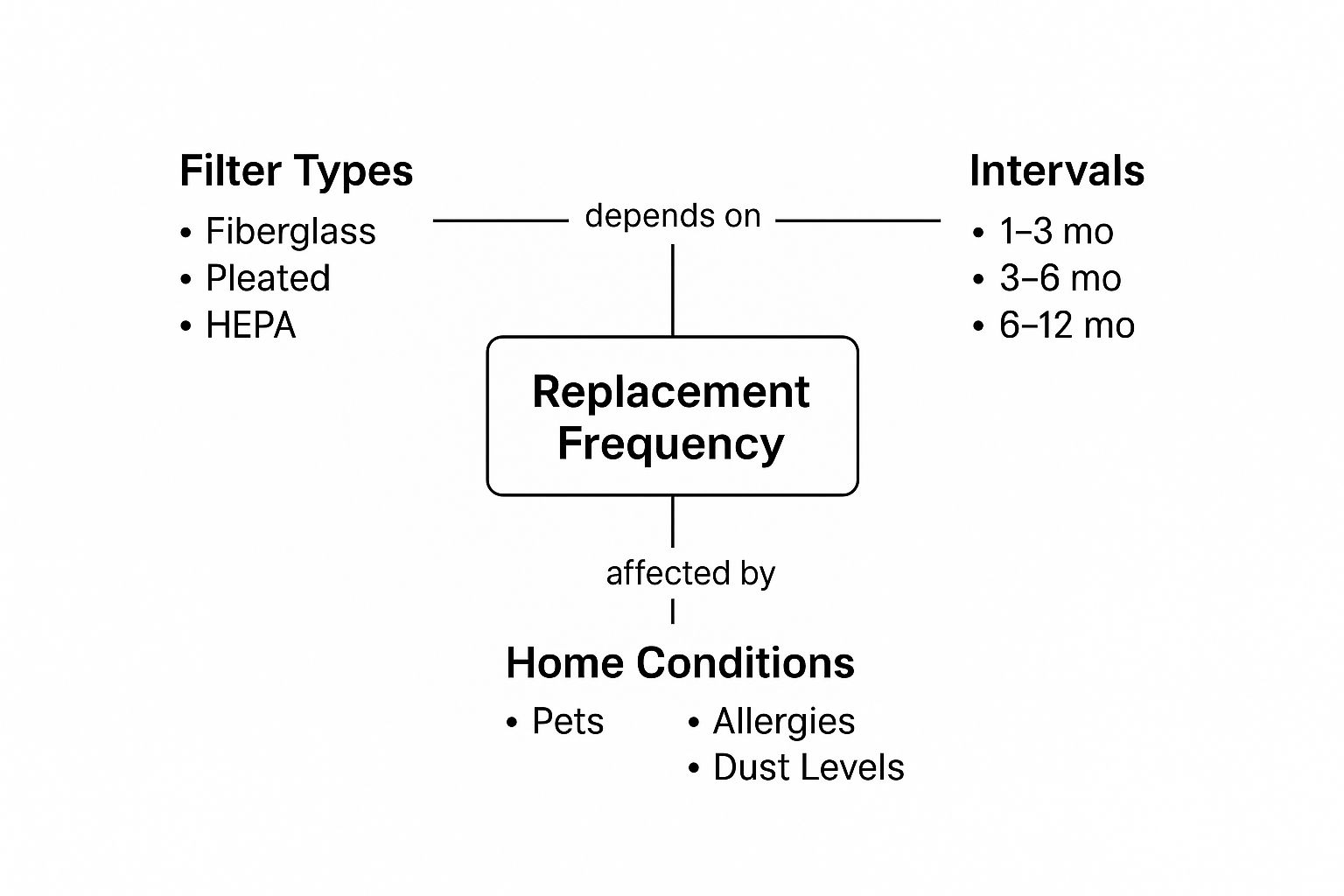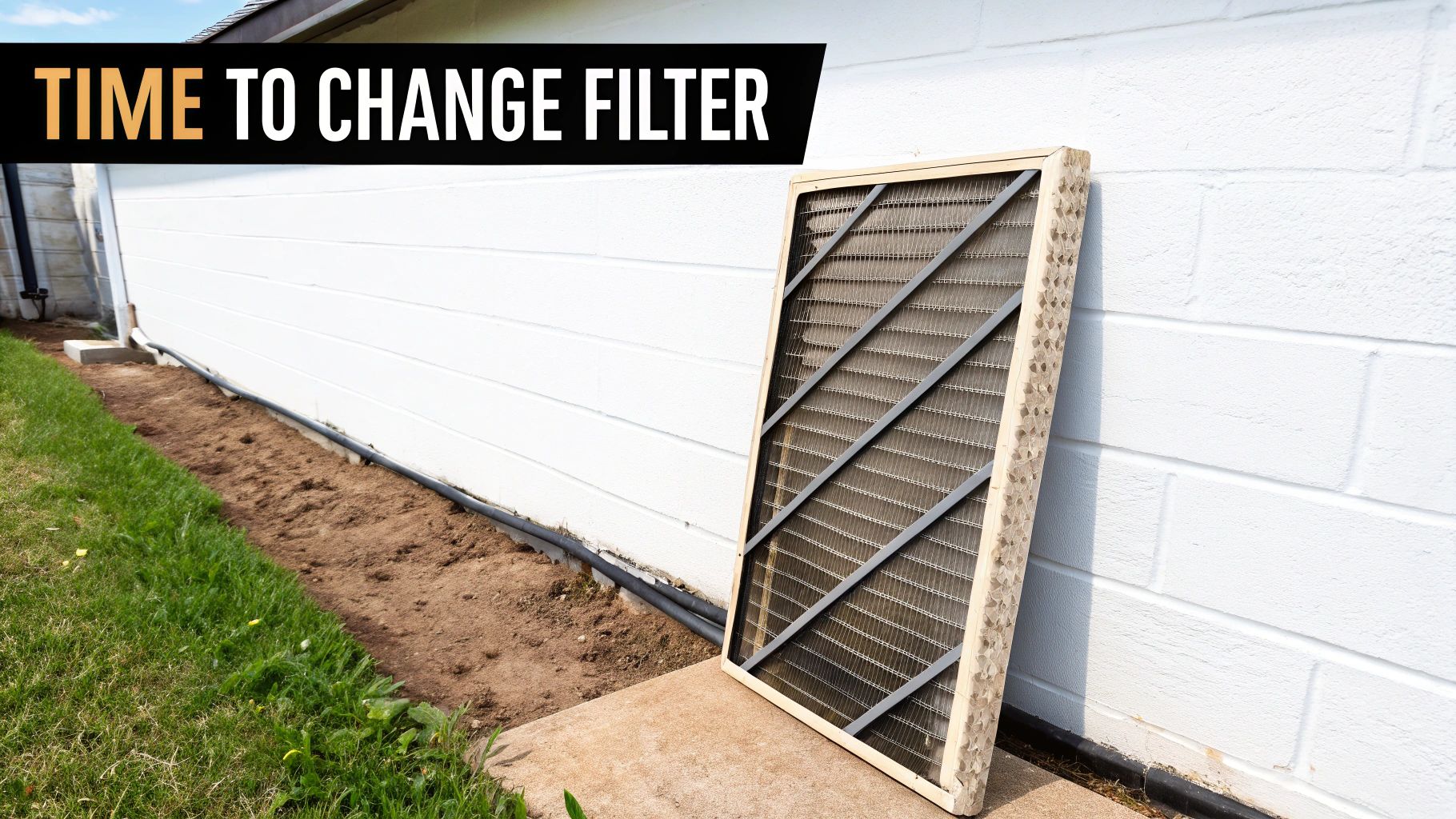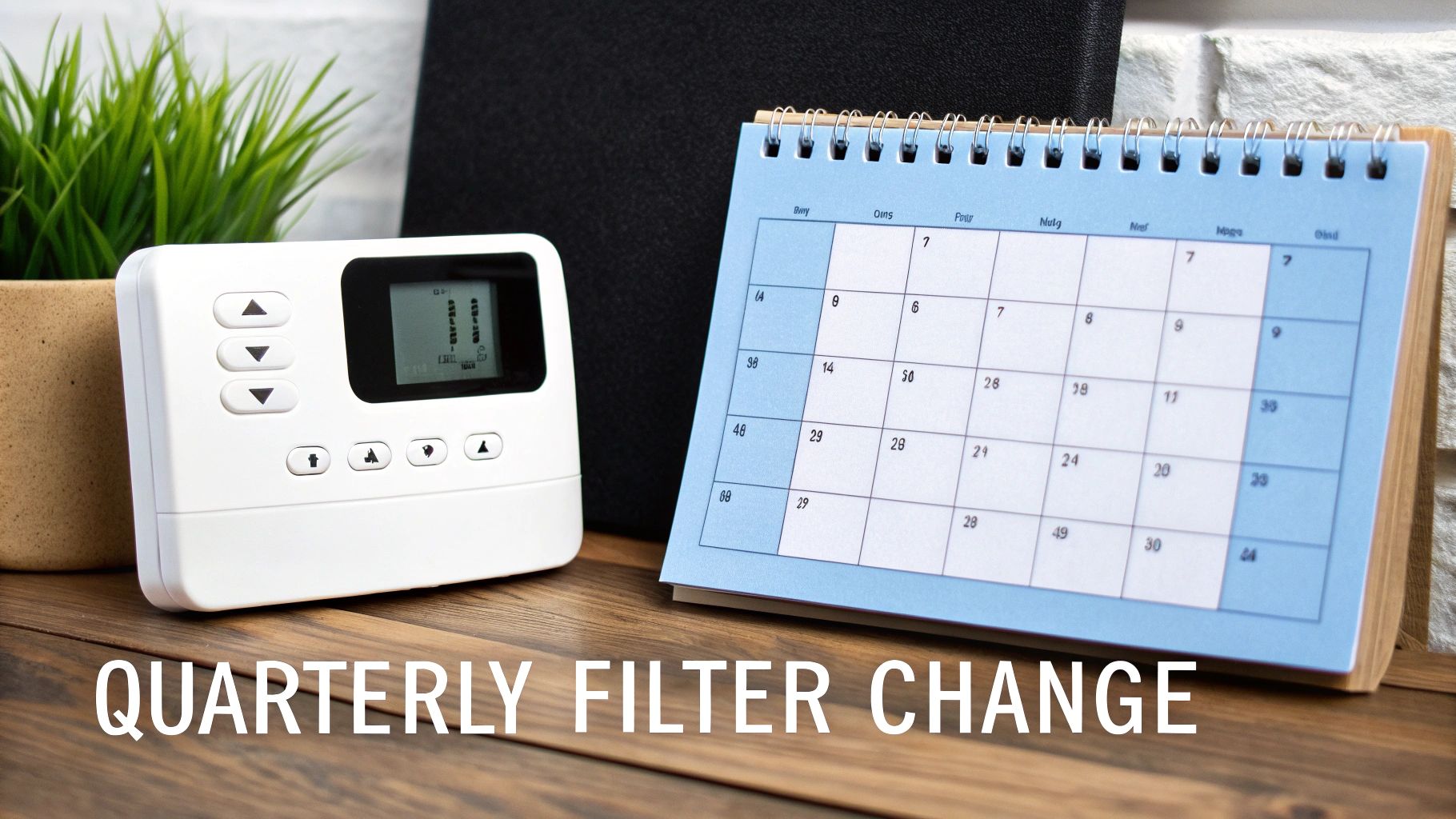The general rule of thumb you’ll often hear is to change your furnace filter every 30 to 90 days. It’s not a hard-and-fast rule, but it's a solid starting point for keeping your home’s air fresh and your HVAC system happy.
Your Guide to Filter Replacement Schedules
Think of your furnace filter as the lungs of your HVAC system. A clean filter lets your furnace "breathe" easily, pulling in and circulating air without any strain. But once it gets clogged with dust, pet dander, and all the other gunk floating around, it starts to suffocate.
This forces your entire system to work overtime just to do its job, which can lead to sky-high energy bills and, even worse, costly breakdowns.
That 30-to-90-day window is a great baseline, but your actual schedule depends on a few things. The type of filter you use makes a huge difference, as does having pets or family members with allergies. For example, a basic fibreglass filter might need swapping out every month, while a higher-end pleated filter could last much longer. We break down all the options in our guide to choosing the right furnace air filter.
A dirty filter is one of the most common—and preventable—causes of HVAC system failure. Staying on top of this simple task can save you from a major repair headache down the road.
To help you figure out the best schedule for your home, here's a quick reference guide.
Quick Guide to Furnace Filter Replacement Schedules
This table gives you a starting point for how often you should be swapping out your filter based on its type and your household conditions.
| Filter Type | Typical Household | Household with Pets or Allergies |
|---|---|---|
| Fibreglass Filters (Basic) | Every 30 days | Every 2-3 weeks |
| Pleated Filters (MERV 6-8) | Every 60-90 days | Every 45-60 days |
| High-Efficiency Filters (MERV 9-12) | Every 3-6 months | Every 2-3 months |
Remember, this is just a guide! If your home is particularly dusty, you're in the middle of a renovation, or you notice the filter looks dirty before its time is up, it's always better to change it early.
What Factors Change Your Filter Schedule
That 30-to-90-day rule for changing your furnace filter? It’s a great starting point, but it's far from a one-size-fits-all solution. Think of it like the maintenance schedule for your car—you wouldn’t follow the same oil change interval if you were off-roading every day versus just driving to the local shops once a week. The same logic applies to your home; several key factors can clog up your filter much faster than you’d expect.
Your daily habits and home environment have a direct line to your filter's lifespan. The more you've got going on inside, the more gunk is floating around for your HVAC system to catch. Getting a handle on these variables is the key to moving beyond a generic calendar reminder to a schedule that’s actually right for your home.

As you can see, what’s happening in your home is just as important as the type of filter you buy when figuring out how often to swap it out.
Your Home Environment and Lifestyle
The conditions inside your home are easily the biggest influence on how long your filter lasts. A quiet, single-person apartment will have a completely different filter replacement timeline than a busy family home with a couple of golden retrievers.
Here are the most common things to keep in mind:
- Pets: Our furry family members are a huge source of dander, hair, and dust. If you have pets, particularly heavy shedders, you’ll want to check and probably change your filter closer to the 30-day mark. Learning how to get rid of pesky pet dander can also give your air quality a serious boost.
- Household Size: More people means more movement, more dust, and more particles getting kicked up into the air. A large family will clog a filter much faster than someone living solo.
- Allergies or Asthma: If anyone in the house struggles with respiratory issues, frequent filter changes are non-negotiable. A clean filter is your best defence against airborne triggers like pollen, dust mites, and mould spores.
External and System-Related Factors
It’s not just what’s happening inside that matters. How hard your HVAC system is working and what’s going on outside your front door play a big role, too.
Think of your furnace filter as a bouncer at a club. Its job gets a lot harder depending on the crowd both inside and outside. When your system is running non-stop or the air outside is full of dust and pollen, that bouncer is working overtime and is going to need a break—or a replacement—much sooner.
Seasonal changes are a classic example. During a frigid Ontario winter or a sweltering summer, your furnace or AC is likely running around the clock. That constant airflow means the filter is trapping particles 24/7, getting dirty way faster than it would in the mild spring or autumn.
Likewise, if you live near a construction site, a major road, or in an area with lots of seasonal pollen, your home is constantly being bombarded with outside pollutants. This forces your filter to work much harder, meaning you need to be much more vigilant about checking and changing it.
Choosing the Right Filter for Your Home
Picking the right furnace filter isn't a one-size-fits-all deal. It's more like choosing the right tool for a very specific job—your home's air quality. Not all filters are made the same, and figuring out the differences is the key to balancing clean air, an efficient furnace, and a sensible maintenance schedule.
The easiest way to understand a filter's power is its MERV rating, which stands for Minimum Efficiency Reporting Value. Think of it as a simple effectiveness scale.
A filter with a low MERV rating (around 1-4) is like a basic screen door. It’ll stop the big stuff like lint and dust bunnies, but smaller particles can waltz right through. On the other end, a filter with a higher MERV rating (8-13) has a much denser weave, allowing it to capture finer particles like pollen, pet dander, and even some mould spores.

Finding Your Perfect Match
Now, you might think a higher MERV rating is always better, but that's not necessarily true. A super-dense filter can actually restrict airflow, forcing your furnace to work much harder than it should. This is where finding that sweet spot becomes critical for your furnace filter replacement frequency.
Here’s a quick rundown of what you’ll typically find on the shelf:
- Fibreglass Filters: These are your basic, budget-friendly option. With a low MERV rating, they mainly protect your furnace from large debris but don’t do much for air quality. You’ll need to swap these out every 30 days.
- Pleated Filters: This is the go-to choice for most homeowners. With a MERV rating between 6-12, they trap a good range of airborne particles without choking your system’s airflow. Plan on replacing them every 60-90 days.
- Electrostatic Filters: These are usually washable and use static electricity to grab particles out of the air. They cost more upfront but can last for years if you keep them clean.
Choosing a thicker filter can also make a significant difference. Research from California's Energy Commission shows that switching from a 1-inch to a 2-inch filter with a MERV 13 rating can lower furnace fan energy use by 5-15% by improving airflow.
At the end of the day, your goal is to find a filter that gives you the best filtration your HVAC system can handle without putting it under strain. If you’re worried about specific pollutants, our guide explains how to check the air quality in your home to help you decide if a higher-rated filter is the right move for you.
Signs Your Furnace Filter Needs Changing Now
While sticking to a schedule is a great starting point, sometimes your HVAC system will tell you exactly what it needs. Learning to read the signs of a clogged filter helps you adjust your furnace filter replacement frequency based on what’s actually happening in your home, not just what the calendar says. Ignoring these clues can lead to bigger bills and put a lot of unnecessary stress on your furnace.
The most obvious sign is, of course, the filter itself. A quick peek can tell you everything you need to know. If you see a thick, grey blanket of dust, pet hair, and other gunk caked onto the surface, it’s time for a change. If you can't even see the original filter material anymore, it’s long overdue.

Beyond The Filter Itself
Other signs are a bit more subtle, but they're just as critical. Paying attention to the sounds and feel of your home can reveal a lot about a struggling system.
Think of a clogged filter as a roadblock for air. Your furnace has to work much harder to push air through that barrier, which causes a few common symptoms you can easily spot:
- Weakened Airflow: Does the air coming from your vents feel a little sluggish? A clogged filter is the number one culprit. It’s physically blocking the air from circulating properly.
- More Dust on Surfaces: Finding yourself dusting the furniture more often than usual? A filter that’s completely full can’t trap any more particles, so it lets all that dust blow right back into your rooms.
- Unexplained Energy Bill Spikes: When your furnace has to fight against a blockage, it runs longer and harder to heat your home. That extra effort shows up directly on your utility bill.
A dirty filter can increase your furnace's energy consumption by up to 15%. That’s a steep price to pay for such a simple maintenance task.
If you've put in a fresh filter and the airflow is still weak, it might point to a bigger issue deeper in your system. You can learn more about the warning signs of clogged vents in our detailed guide. Catching these problems early is the best way to protect your HVAC system and keep your home comfortable.
Creating a Simple Filter Replacement System
Knowing you should change your furnace filter is the easy part. Actually remembering to do it? That's a different story. The best maintenance plan is the one you actually stick to, so let's make it easy.
One of the simplest tricks is right in your pocket. The moment you pop a new filter in, grab your phone and set a recurring calendar reminder. Call it "Change Furnace Filter" and set it to repeat every 30, 60, or 90 days, depending on what your home needs. It takes less than a minute and completely automates the task.
Low-Tech Tracking Methods
If you'd rather not rely on technology, go old-school with a permanent marker. Just jot down the date you installed the filter right on its cardboard frame. Now, every time you're near the furnace, you'll have a clear visual cue of how long it's been working.
Here’s another great habit to build: the "monthly glance." Set a reminder for the first of every month to just take a quick 30-second peek at your filter. You might not need to change it, but it guarantees a dirty, clogged filter won't go unnoticed for long, especially when your furnace or AC is working overtime.
Building these small habits does more than just tick a box on your to-do list; it protects your entire HVAC system from the strain of a clogged filter. Regular changes boost efficiency and are a cornerstone of good ductwork health. To learn more about that, take a look at our guide on how to maintain your air duct systems. A simple routine keeps your system running smoothly, safeguarding your air quality and saving you from a surprise repair bill down the road.
Common Questions About Furnace Filters
Even with a solid plan, a few questions about furnace filters always seem to come up. Getting the right answers helps you manage your system with confidence and sidestep common mistakes that can mess with your home’s air quality and your furnace's health.

We've pulled together the most frequent questions homeowners ask about their furnace filter replacement frequency, with straightforward answers to keep you on the right track.
Does the Arrow on the Filter Matter During Installation
Absolutely. That little arrow printed on the filter's frame is critical—it needs to point toward the furnace itself, following the direction the air flows.
Putting it in backward chokes the airflow and can cause the filter to bend or even collapse under the pressure. This not only makes the filter useless but can lead to some serious internal damage to your HVAC system.
What Happens If I Forget to Change My Filter
Forgetting to swap out your filter makes your entire HVAC system work way harder than it should. It’s like trying to breathe through a pillow. This strain leads to higher energy bills, weaker heating and cooling, and puts a ton of stress on expensive parts like the fan motor.
If left long enough, it can cause the whole system to overheat and shut down completely. That means you're looking at a costly repair call and a much shorter lifespan for your furnace.
Neglecting a filter change can increase your furnace's energy use by up to 15%. A dirty filter makes your system struggle, and you'll see that struggle reflected directly in your monthly utility costs.
Can I Clean and Reuse a Disposable Furnace Filter
Definitely not. Disposable filters are strictly single-use for a reason. Trying to vacuum or wash them just wrecks the delicate filter material, rendering them useless and letting all that dust and debris pass straight through into your HVAC system.
Only filters specifically marked as "washable" or "reusable" should ever be cleaned. Even then, you have to follow the manufacturer's drying instructions perfectly to prevent mould from growing. Sticking to the rules here is the best way to keep your furnace running efficiently.
Keeping your home's air clean and your HVAC system running smoothly is what we do best. For expert duct cleaning and furnace maintenance in the GTA, trust the experienced team at Can Do Duct Cleaning. Visit our website to schedule your service today!


